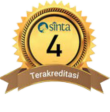Da'wah Strategy of the Tabligh Majelis Of Muhammadiyah Padang Sidempuan Regional Leadership in Fostering Religious Harmony
Abstract
This research is entitled "Da'wah Strategy of the Padang Sidimpuan Muhammadiyah Regional Leadership Tabligh Council in Fostering Religious Harmony." The aim of this research is to determine the state of religious harmony in the city of Padang Sidimpuan, the da'wah strategy of the Tabligh assembly of the Muhammadiyah regional leadership in Padang Sidimpuan City in improving the development of religious harmony in Padang Sidimpuan City, as well as supporting factors and factors inhibiting religious harmony in the city of Padang Sidimpuan. In this research, the researcher uses a qualitative methodology with a descriptive approach. Data collection techniques in this research are observation, interviews, and documentation. The location of this study was carried out at the Regional Muhammadiyah Leadership office in Padang Sidimpuan City, at the Majelis Ulama Indonesia Padang Sidimpuan office, and at the office of the Padang Sidimpuan Religion Ministry. The results of this research are: 1) The state of religious harmony in the city of Padang Sidimpuan can actually be said to be good; there is no misunderstanding or a high level of tolerance because the people in the city of Padang Sidimpuan generally still have unity in creating a harmonious society. in everyday life. 2) Supporting and inhibiting factors are (a) the existence of awareness of religious communities, a sense of kinship, and religious tolerance, thereby creating a sense of equality and harmony among religious communities in the city of Padang Sidimpuan, and (b) frequent events that occur to create harmony among religious communities. In the city of Padang Sidimpuan, there was a misunderstanding caused by a third party (an outside party). So that, with this research, the Tablighi assembly's Islamic da'wah will continue to develop and be able to overcome similar factors that will occur in the future.
Keywords
Full Text:
PDFReferences
ABIDIN, K. (2020). KOMUNIKASI INTERPERSONAL DALAM DAKWAH KELOMPOK JAMAAH TABLIGH. Al-Din: Jurnal Dakwah Dan Sosial Keagamaan, 5(1). https://doi.org/10.35673/ajdsk.v5i1.575
Alifuddin, M. (2020). Dakwah Muhammadiyah dalam Membangun Kesadaran Nasional di Kendari Masa Pra Kemerdekaan: Perspektif Gerakan Sosial. Al-MUNZIR, 13(2). https://doi.org/10.31332/am.v13i2.1968
Alwi, I., Amin, M., & Arifuddin. (2021). Gerakan dakwah majelis tabligh muhammadiyah di kota makassar. Jurnal Mercusuar, 2(2).
Anggraeni, D., & Suprabowo, I. (2022). Strategi dakwah di masa pandemi: Studi pada Majelis Tabligh Pimpinan Pusat Aisyiyah. Islamic Communication Journal, 7(1). https://doi.org/10.21580/icj.2022.7.1.10252
Awalia, S. & dkk. (2022). Sistem Informasi Manajemen: Tujuan Sistem Informasi Manajemen. CV. Pena Persada, April.
Doni Saepol Aziz, Ms Udin, I. (2022). Problematika Dakwah Jamaah Tabligh Di Desa Tanjung Kabupaten Lombok Utara NTB. Jurnal Ilmu Sosial, 1(2).
Fauzi, F. N., & Indah, E. O. (2021). KONTRIBUSI ILMU KOMUNIKASI PADA ILMU DAKWAH. Ath Thariq Jurnal Dakwah Dan Komunikasi, 5(1). https://doi.org/10.32332/ath_thariq.v5i1.2998
Huda, S., Maulana Mas’udi, M., & Muthohirin, N. (2022). The Rise of Muhammadiyah’s Islamic Da’wah in the Contemporary Era: Transformation to Online Trend and Responses to Islamic Moderation. Progresiva : Jurnal Pemikiran Dan Pendidikan Islam, 11(01). https://doi.org/10.22219/progresiva.v11i01.20889
Istkomah, I., Romadlon, D. A., & Hariyanto, B. (2020). Strategi Dakwah Muhammadiyah Melalui FKMMS (Forum Komunikasi Masjid Muhammadiyah Sidoarjo). KOMUNIKA: Jurnal Dakwah Dan Komunikasi, 14(1). https://doi.org/10.24090/komunika.v14i1.3341
Mahmud, A. (2020). Hakikat Manajemen Dakwah. Palita: Journal of Social Religion Research, 5(1). https://doi.org/10.24256/pal.v5i1.1329
Masmuddin, M. (2019). Dakwah Jamaah Tabligh dalam Perspektif Masyarakat Kota Palopo. In Misykat al-Anwar Jurnal Kajian Islam dan ….
Nuraedah, N., & Mutawakkil, M. (2020). The Da’wah Communication Strategy of Jamaah Tabligh in Sub-district of Tondo, Palu City. Ilmu Dakwah: Academic Journal for Homiletic Studies, 14(2). https://doi.org/10.15575/idajhs.v14i2.10220
PRABOWO, E., & ZEN, M. (2023). The Effect of Product Innovation and Market Orientation on Performance Muhammadiyah Da’wah Institute Marketing. Journal of Entrepreneurial and Business Diversity, 1(1). https://doi.org/10.38142/jebd.v1i1.40
Rakananda, M. R., Sunarto Putri, F. L., Rakananda, M. R., Romadhoni, I. Z., & Hidayah, A. N. (2022). Perkembangan Dakwah Muhammadiyah di Desa Pamijen, Sokaraja. COMSERVA Indonesian Jurnal of Community Services and Development, 1(10). https://doi.org/10.36418/comserva.v1i10.71
Rodian, R., & Rosidi, I. (2022). Da’wah and Social Change in ISlamic Organizations Muhammadiyah and Its Elements. AJIQS, 5(1).
Ruji, M., & Faisol, A. H. (2021). Strategi Dakwah Jamaah Tabligh dalam Tazkiyat Al-Nafs di Masjid PP. Darul Ulum Pakes Desa Panaan Palengaan Pamekasan. DA’WA: Jurnal Bimbingan Penyuluhan & Konseling Islam, 1(1). https://doi.org/10.36420/dawa.v1i1.12
Saifulazry, M., Azmin, P., Mohd Nur Hidayat, H., & Sharifah Darmia, S. A. (2022). Kepentingan Ilmu Dakwah Terhadap Pendakwah Kontemporari Menurut Perspektif Muhammad Al-Ghazali Satu Analisis. JISED: Journal of Islamic, Social, Economics and Development, 7(47).
Sari, R. W., & Kuswono, K. (2022). PERKEMBANGAN CABANG MUHAMMADIYAH METRO PUSAT BIDANG DAKWAH PENDIDIKAN TAHUN 2006-2019. SWARNADWIPA, 4(1). https://doi.org/10.24127/sd.v4i1.1972
Slamet, A., & Laila, A. F. (2019). Strategi Dakwah Nahdlatul Ulama dan Muhammadiyah di Kabupaten Jepara dalam Perspektif Pemanfaatan Media Massa. An-Nida : Jurnal Komunikasi Islam, 10(1). https://doi.org/10.34001/an.v10i1.748
Sugiyono, Prof. DR. (2019). Buku sugiyono, metode penelitian kuantitatif kualitatif. In Revista Brasileira de Linguística Aplicada (Vol. 5, Issue 1).
DOI: https://doi.org/10.34001/jasna.v4i2.6834
Article Metrics
Refbacks
- There are currently no refbacks.
JASNA : Journal For Aswaja Studies is licensed under a Creative Commons Attribution 4.0 International License.
IT Support by Data Center and IT Development Unisnu Jepara
INDEX BY :










